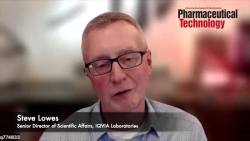
OR WAIT null SECS
- About Us
- Advertise
- Contact Us
- Editorial Info
- Editorial Advisory Board
- Do Not Sell My Personal Information
- Privacy Policy
- Terms and Conditions
© 2025 MJH Life Sciences™ , Pharmaceutical Technology - Pharma News and Development Insights. All rights reserved.
Raman Spectroscopy System Allows On-line Process Measurement
Tornado Spectral Systems, winner of the 2018 CPhI Excellence in Pharma Award for Analysis, Testing, and Quality Control, discusses real-time process measurement for biopharmaceutical and small-molecule drug manufacturing.
On-line, real-time process measurements have advantages over off-line, laboratory measurements for creating efficient, high quality manufacturing processes. Pharmaceutical Technology spoke with Mark Kemper, director of Applications and Customer Service at Tornado Spectral Systems, which won the 2018 CPhI Excellence in Pharma Award: Analysis, Testing, and Quality Control, about the company’s HyperFlux PRO Plus Raman spectrometer. The instrument uses the company’s proprietary high-throughput virtual slit (HTVS) technology for high sensitivity, low detection limits, and fast measurements for high process responsivity. It is currently used in both batch and continuous pharmaceutical manufacturing.
Raman applications
PharmTech: What are the primary applications in pharmaceutical manufacturing for real-time process measurement using the HyperFlux PRO Plus Raman spectrometer?
Kemper (Tornado): The scope of application extends into many industries, but the markets we initially saw the most demand from were traditional pharma: small molecule and API. These areas were most of our focus and aim as well. Interestingly, the biopharmaceutical industry has now surpassed others as the industry with the most demand. Our main markets globally and within the biopharmaceutical space are cell fermentation and purification.
Our Raman spectroscopy system has systematically been making its way into the biopharmaceutical industry, and we are now starting to see the product trickle down to downstream purification applications. The feedback from the market is that Raman is currently the fastest measurement system for downstream purification, and many downstream customers are now carrying out R&D using Raman.
The traditional small-molecule market is also finding new applications as well. With the conversion to continuous manufacturing increasing, many companies are finding our technology useful for blend uniformity. The speed with which we are able to measure is a major advantage.
PharmTech: Are there limitations where one might need to use a different method, such as near infrared (NIR)?
Kemper (Tornado): Fluorescence is one of the major issues that we encounter, and NIR is certainly a good alternative where this is a debilitating problem. Even with fluorescence, however, if the Raman signal can be seen over the fluorescence signal, a successful measurement can often be made. Another area where Raman has limitations involves the measurement of water. Of course, water is a very poor Raman scatterer, so NIR is a much better method for that application.
Validation and set up
PharmTech: Are the real-time/on-line measurements validated in comparison to off-line laboratory measurements? If so, what are some of the steps needed to do this?
Kemper (Tornado): Lab measurements have much different requirements and disparate goals compared to process measurements. Determination of feasibility in the lab is, of course, where most process measurements begin. Carrying those calibration models to the process can be challenging, however, as it is sometimes difficult to simulate process samples in a lab environment. Often, a starter calibration can be inoculated with process sample data to make it more robust toward on-line measurements. The most direct way to set up models for in-line data is to take measurements in-line and sample from the line at carefully timed intervals to acquire corresponding reference data to construct a calibration. Another approach that is often not seriously considered is the use of Raman data a priori without reference data. Very often, qualitative models can provide the control information necessary without the intrusion of reference data. However, this is generally too big of a step for those used to looking at quantitative data.
PharmTech: What are some of the considerations when setting up this on-line process measurement system?
Kemper (Tornado): The major considerations are whether an immersion or non-contact measurement is required, the fiber lengths that are needed, whether the spectrometer is to be set in a control room or near the process and, of course, what sort of probe dimensions and finishes are best suited for the application at hand.



